Avoid getting scammed by fake MetaMask emails requesting cryptowallet verification
![]() Written by Tomas Meskauskas on (updated)
Written by Tomas Meskauskas on (updated)
What is the "MetaMask" scam email?
"MetaMask email scam" is a phishing spam campaign. The scam emails are disguised as verification requests from MetaMask - cryptocurrency wallet software interacting with the Ethereum blockchain. It must be emphasized that these letters are fake and in no way associated with ConsenSys Software Inc. - the developers of MetaMask.
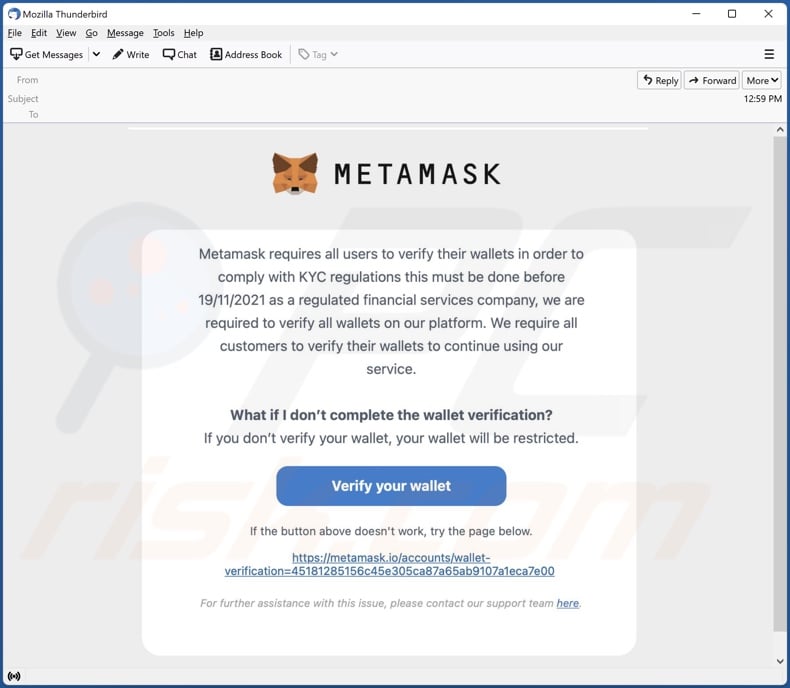
"MetaMask" email scam overview
The fake "MetaMask" emails claim that recipients need to verify their cryptowallets to meet the newest regulations. If the verification is not completed until a specific date, the wallet will be restricted.
The button/link presented in these letters redirect to a phishing website disguised as a MetaMask page. This webpage requests users to provide their wallet keyword phrase. Phishing content operates by recording the information entered into it. Hence, by trusting the "MetaMask" scam emails - users can have their cryptocurrency wallets stolen. This in turn, can result in privacy issues and significant financial losses.
| Name | MetaMask Email Scam |
| Threat Type | Phishing, Scam, Social Engineering, Fraud |
| Fake Claim | Scam emails claim that recipients' cryptowallets require verification. |
| Disguise | Scam emails are disguised as notifications from MetaMask. |
| Related Domains | official-bakeryswap[.]org, xxxbnxcvbxxxwere[.]work[.]gd, tworkedainamengedineouneedapaidomainamenom[.]line[.]pm |
| Detection Names (official-bakeryswap[.]org) | Emsisoft (Phishing), Fortinet (Phishing), Kaspersky (Phishing), Sophos (Phishing), Full List Of Detections (VirusTotal) |
| Symptoms | Unauthorized online purchases, changed online account passwords, identity theft, illegal access of the computer. |
| Distribution methods | Deceptive emails, rogue online pop-up ads, search engine poisoning techniques, misspelled domains. |
| Damage | Loss of sensitive private information, monetary loss, identity theft. |
| Malware Removal (Windows) | To eliminate possible malware infections, scan your computer with legitimate antivirus software. Our security researchers recommend using Combo Cleaner. |
Spam campaigns in general
".xlsx document for your preview", "download the pending mails manually", "WalletConnect", and "CTT email scam" are some examples of phishing emails.
Spam campaigns are employed not just for various scams but also to proliferate malware (e.g., trojans, ransomware, cryptocurrency miners, etc.). Spam mail is quite widespread - therefore, it is strongly advised to exercise caution with incoming emails and messages.
How do spam campaigns infect computers?
Spam emails can contain virulent files as attachments or download links. These files can be in various formats, e.g., Microsoft Office and PDF documents, archives (ZIP, RAR, etc.), executables (.exe, .run, etc.), JavaScript, and so on. Upon being opened, infectious files trigger malware download/installation.
For example, Microsoft Office documents infect systems by executing malicious macro commands. This process begins when a document is opened in Microsoft Office versions released before 2010. Later versions have "Protected View" mode that stops this automatic process; instead, users can manually enable macros (i.e., editing/content). Note that virulent documents often contain messages designed to lure users into enabling macro commands.
How to avoid installation of malware?
It is advised against opening suspicious and irrelevant emails. The attachments and links present in these letters - must not be opened, as they can cause system infections. It is recommended to use Microsoft Office versions released after 2010.
Aside from spam mail, malware is also spread via dubious download channels (e.g., unofficial and freeware websites, Peer-to-Peer sharing networks, etc.), illegal activation tools ("cracks"), and fake updates. Therefore, it is important to download from official/verified sources and activate/update products with tools provided by genuine developers.
It is crucial to have a dependable anti-virus installed and kept updated. This software has to be used to run regular system scans and to remove detected threats. If you've already opened malicious attachments, we recommend running a scan with Combo Cleaner Antivirus for Windows to automatically eliminate infiltrated malware.
Text presented in the "MetaMask" scam email letter:
METAMASK
Metamask requires all users to verify their wallets in order to comply with KYC regulations this must be done before 19/11/2021 as a regulated financial services company, we are required to verify all wallets on our platform. We require all customers to verify their wallets to continue using our service.
What if I don't complete the wallet verification?
If you don't verify your wallet, your wallet will be restricted.
Verify your wallet
If the button above doesn't work, try the page below.
-
For further assistance with this issue, please contact our support team here.
Screenshot of the phishing site promoted by the "MetaMask" spam campaign:
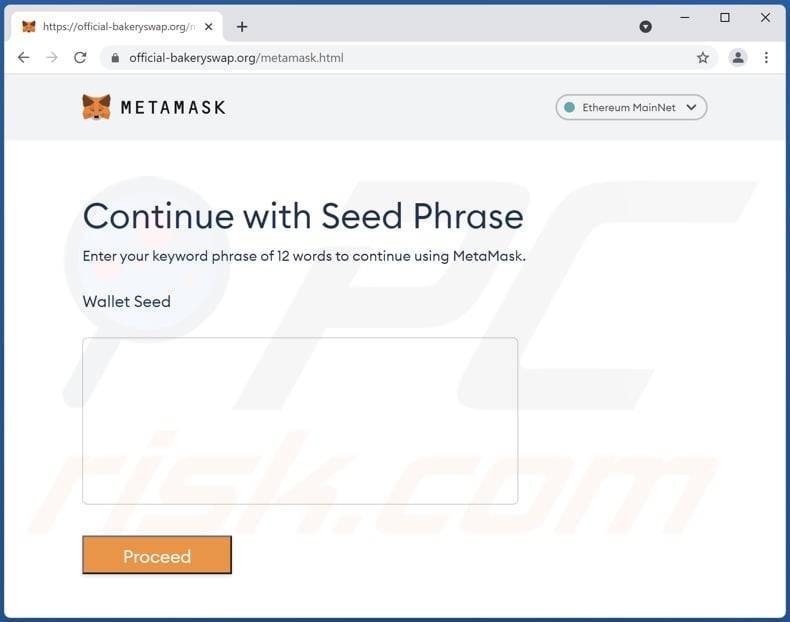
Another example of MetaMask-themed spam email promoting a phishing site:
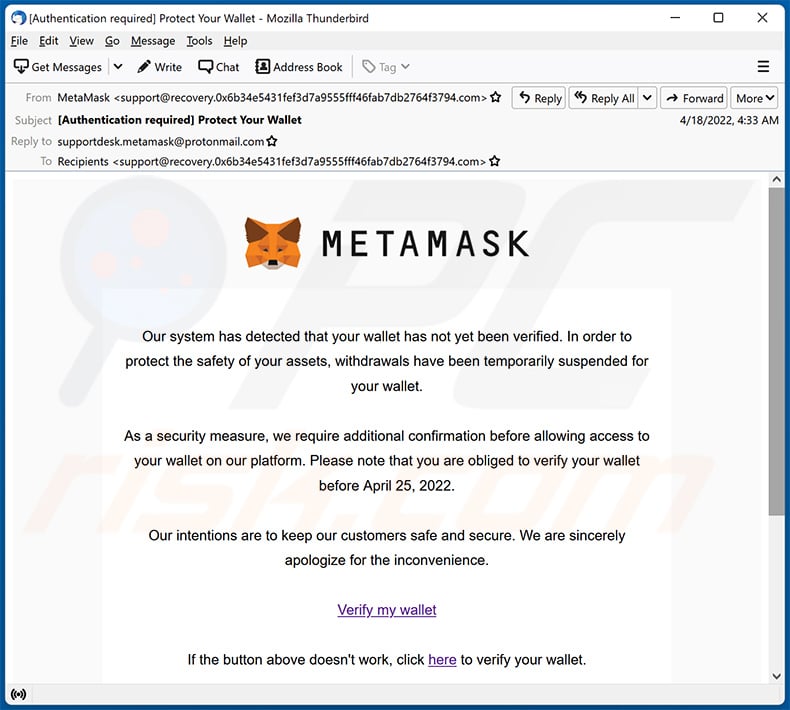
Text presented within:
Subject: [Authentication required] Protect Your Wallet
METAMASK
Our system has detected that your wallet has not yet been verified. In order to protect the safety of your assets, withdrawals have been temporarily suspended for your wallet.
As a security measure, we require additional confirmation before allowing access to your wallet on our platform. Please note that you are obliged to verify your wallet before April 25, 2022.
Our intentions are to keep our customers safe and secure. We are sincerely apologize for the inconvenience.
Verify my wallet
If the button above doesn't work, click here to verify your wallet.
For further assistance with this issue, please contact our support team here.
The MetaMask Team
ConsenSys, 49 Bogart St, New York, NY 11206, United States
Unsubscribe Manage preferences
Yet another example of MetaMask-themed spam email promoting a phishing site:
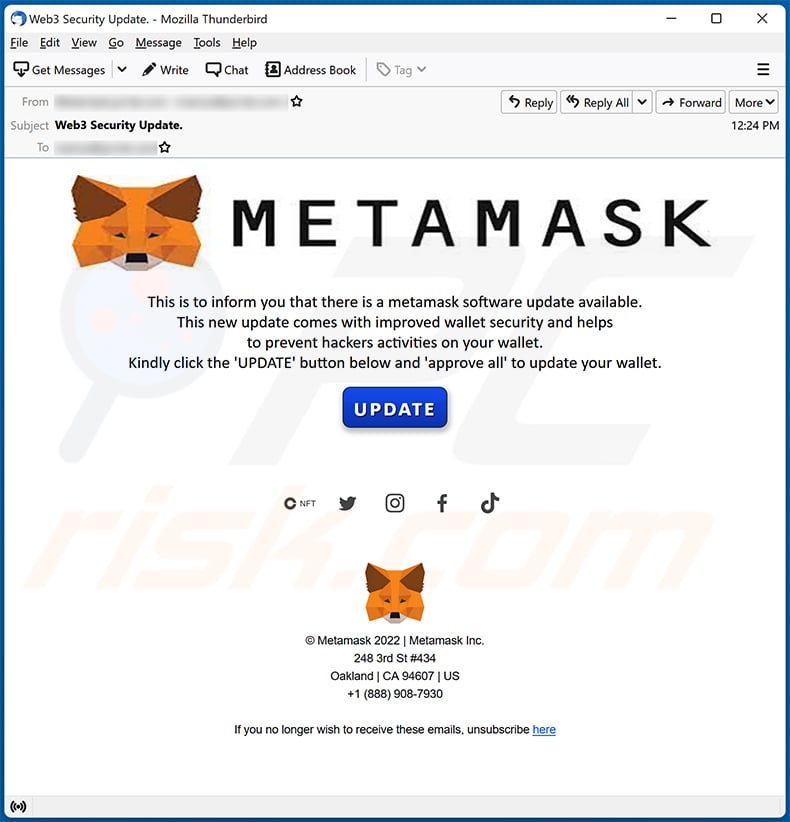
Text presented within:
Subject: Web3 Security Update.
METAMASK
This is to inform you that there is a metamask software update available.
This new update comes with improved wallet security and helps
to prevent hackers activities on your wallet.
Kindly click the 'UPDATE' button below and 'approve all' to update your wallet.
Screenshot of the promoted phishing site:
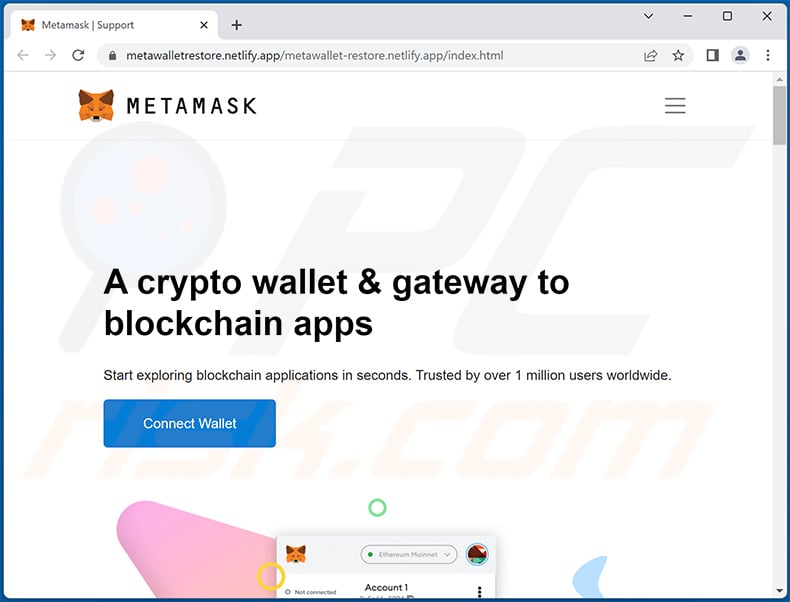
Yet another example of MetaMask-themed spam email:
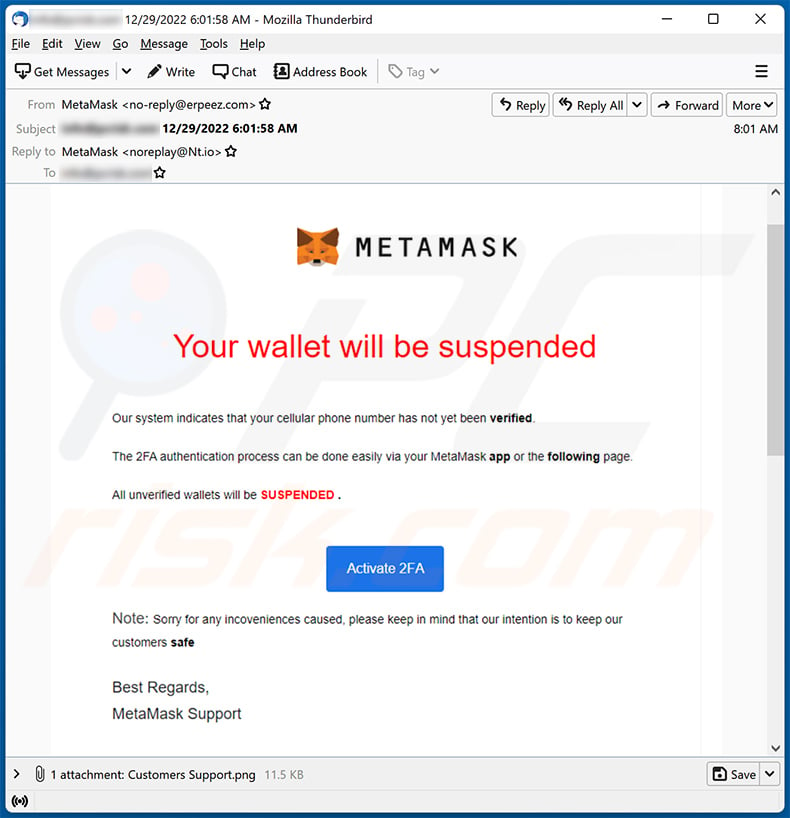
Text presented within:
METAMASK
Your wallet will be suspended
Our system indicates that your cellular phone number has not yet been verified.
The 2FA authentication process can be done easily via your MetaMask app or the following page.
All unverified wallets will be SUSPENDED .
Activate 2FA
Note: Sorry for any inconveniences caused, please keep in mind that our intention is to keep our customers safe
Best Regards,
MetaMask Support2022 MetaMask LLC
1600 Amphitheatre Parkway,
Mountain View, CA 94043
Another example of MetaMask-themed spam email promoting a phishing site:
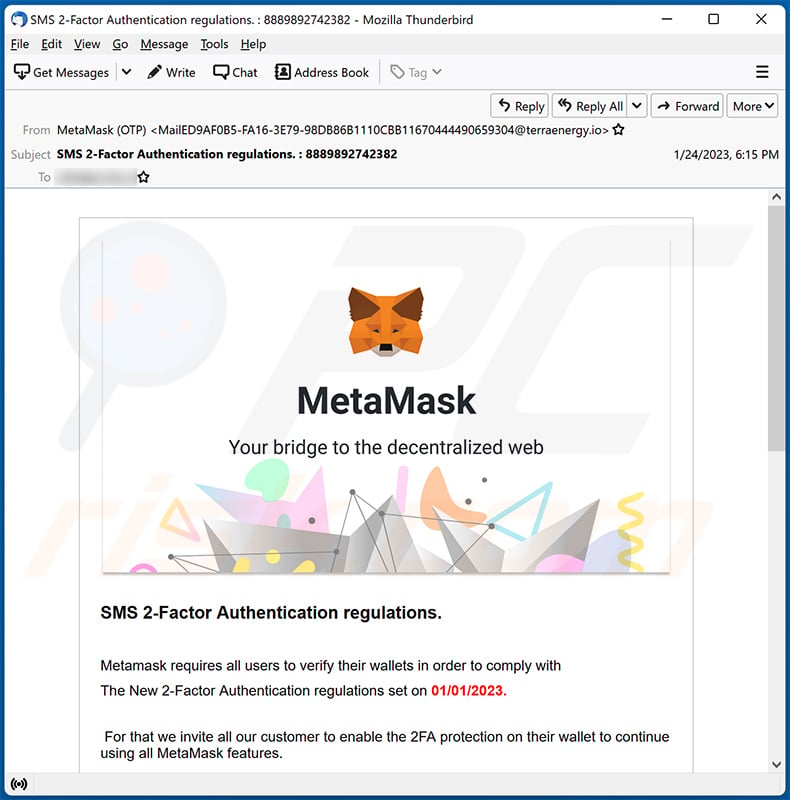
Text presented within:
Subject: SMS 2-Factor Authentication regulations. : 8889892742382
MetaMask Swaps Survey Email Header
SMS 2-Factor Authentication regulations.Metamask requires all users to verify their wallets in order to comply with
The New 2-Factor Authentication regulations set on 01/01/2023.For that we invite all our customer to enable the 2FA protection on their wallet to continue using all MetaMask features.
What if I don' t complete this verification process?
If you don' t verify your wallet, your wallet will be restricted.
Enable 2FA
Thanks again for your valuable feedback.
MetaMask Security Team
49 Bogart St New York NY 11206 United States
Preferences | Unsubscribe
Facebook Link Twitter Link LinkedIn Link
Screenshot of the promoted phishing site:
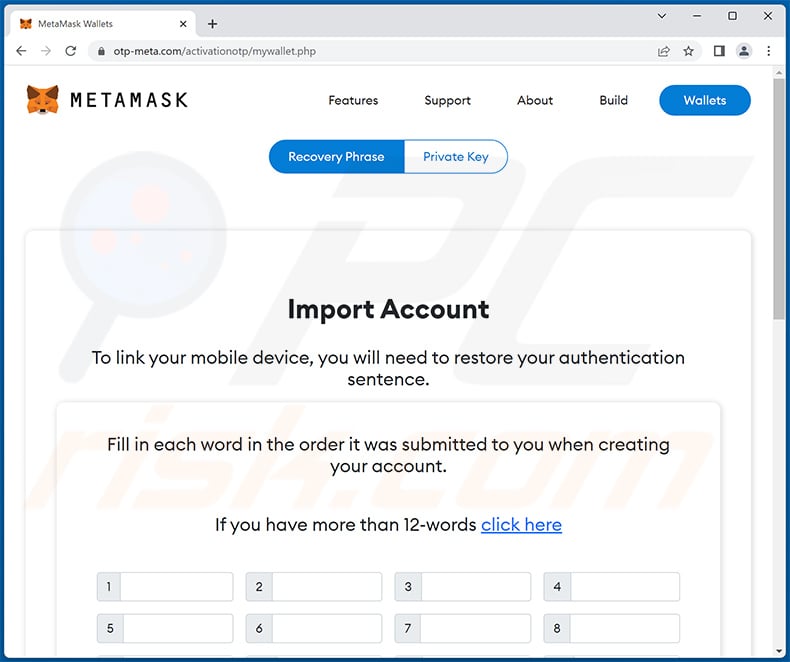
Another example of a spam email from MetaMask spam campaign:
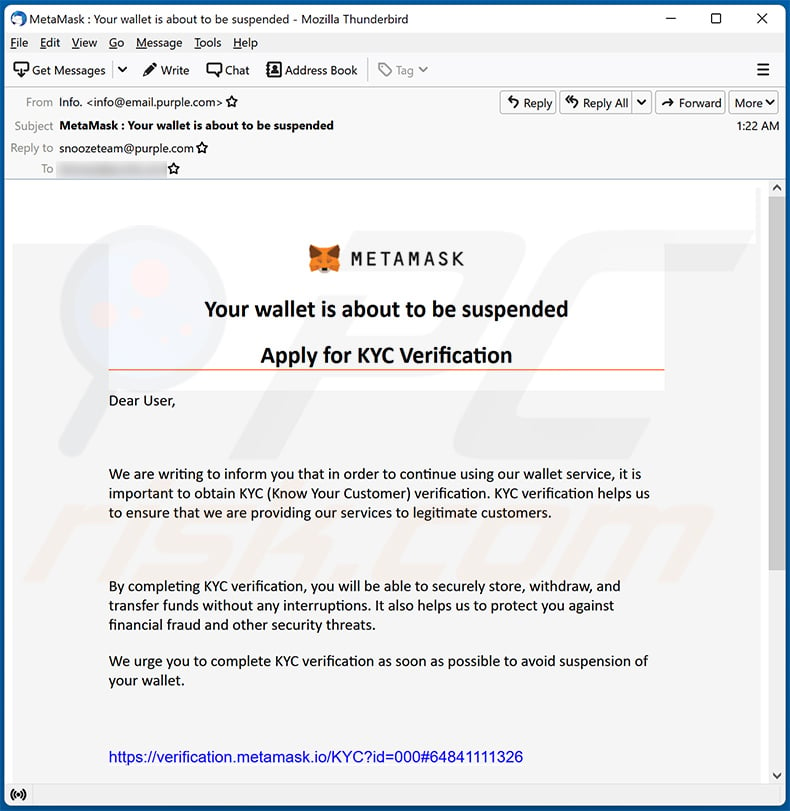
Text presented within:
Votre commande a bien été prise en compte.
Afficher cet email sur un navigateurYour wallet is about to be suspended
Apply for KYC Verification
Dear User,
We are writing to inform you that in order to continue using our wallet service, it is important to obtain KYC (Know Your Customer) verification. KYC verification helps us to ensure that we are providing our services to legitimate customers.
By completing KYC verification, you will be able to securely store, withdraw, and transfer funds without any interruptions. It also helps us to protect you against financial fraud and other security threats.
We urge you to complete KYC verification as soon as possible to avoid suspension of your wallet.
-
Thank you for understanding. Sincerely
Screenshot of the promoted phishing site:
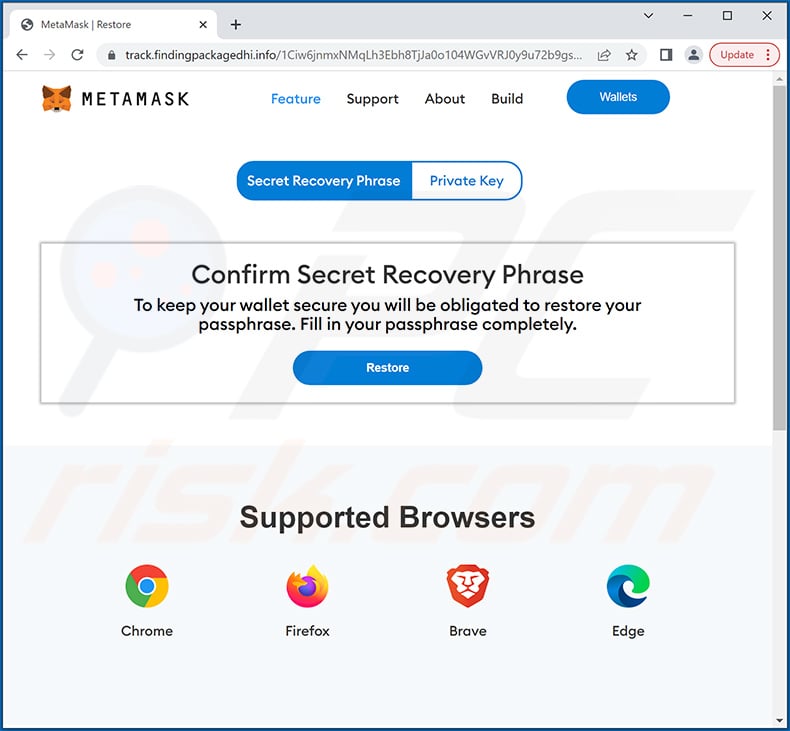
Another example of MetaMask-themed spam email promoting a phishing site:
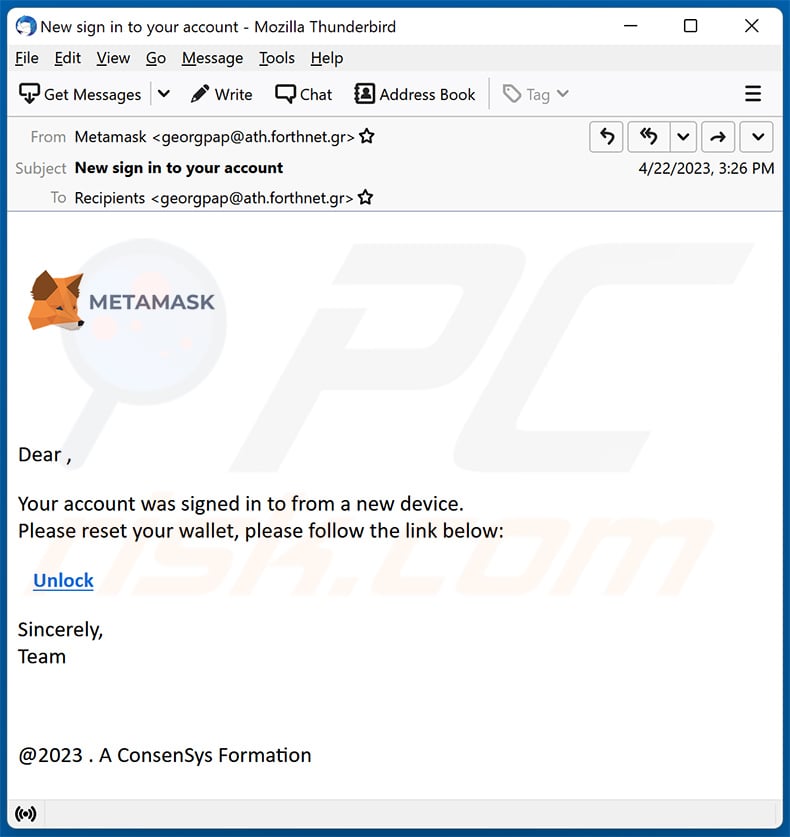
Text presented within:
Subject: New sign in to your account
METAMASK
Dear ,
Your account was signed in to from a new device.
Please reset your wallet, please follow the link below:Unlock
Sincerely,
Team@2023 . A ConsenSys Formation
Screenshot of the promoted phishing site:
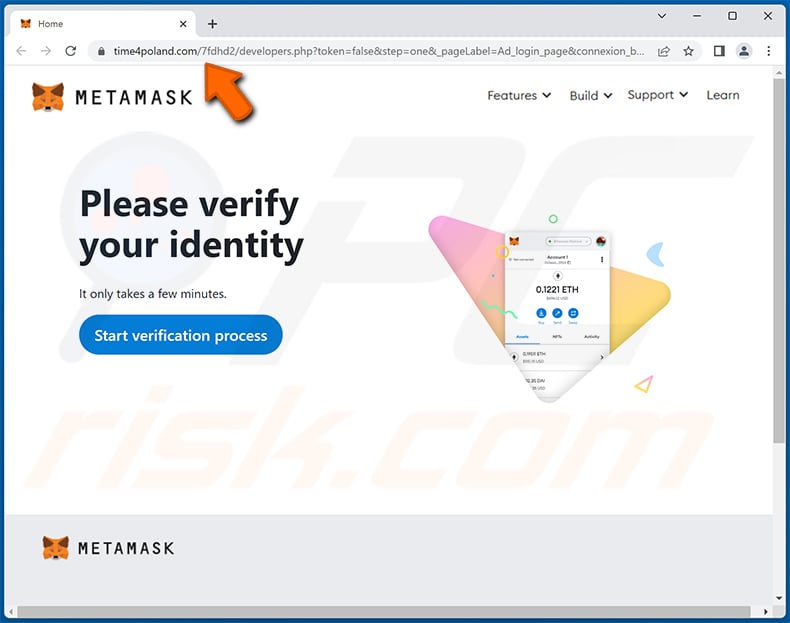
Another scam email asking to verify Metamask wallet:
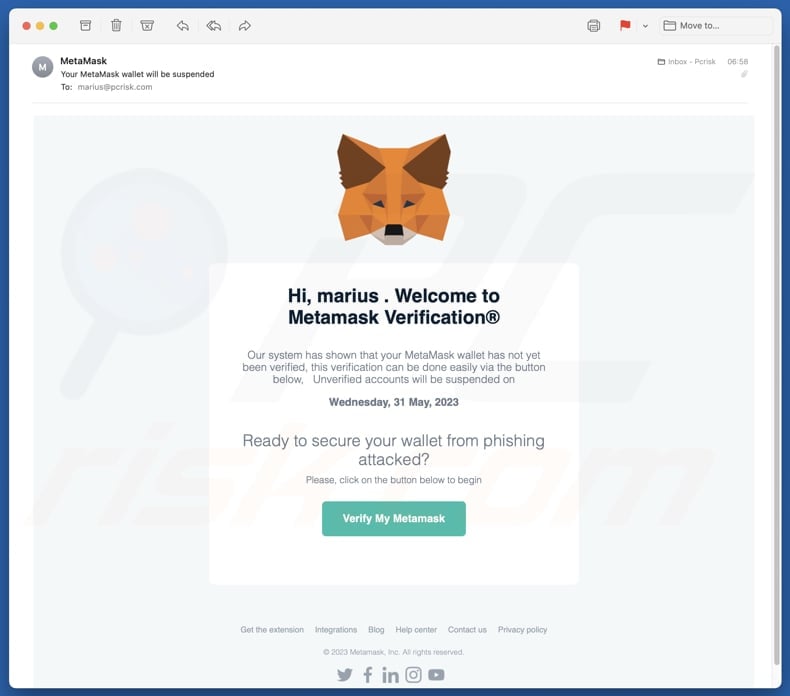
Text in this scam email:
Hi, *. Welcome to Metamask Verification®
Our system has shown that your MetaMask wallet has not yet been verified, this verification can be done easily via the button below, Unverified accounts will be suspended on
Wednesday, 31 May, 2023Ready to secure your wallet from phishing attacked?
Please, click on the button below to begin
Another Metamask wallet verification scam email example:
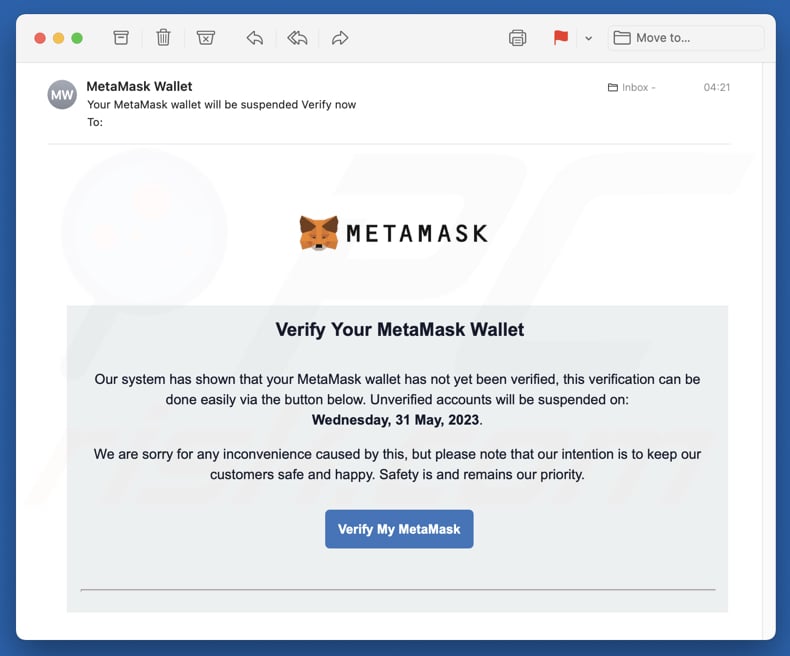
Text in this scam email:
Verify Your MetaMask Wallet
Our system has shown that your MetaMask wallet has not yet been verified, this verification can be done easily via the button below. Unverified accounts will be suspended on:
Wednesday, 31 May, 2023.We are sorry for any inconvenience caused by this, but please note that our intention is to keep our customers safe and happy. Safety is and remains our priority.
Yet another example of an email from MetaMask-themed spam campaign:
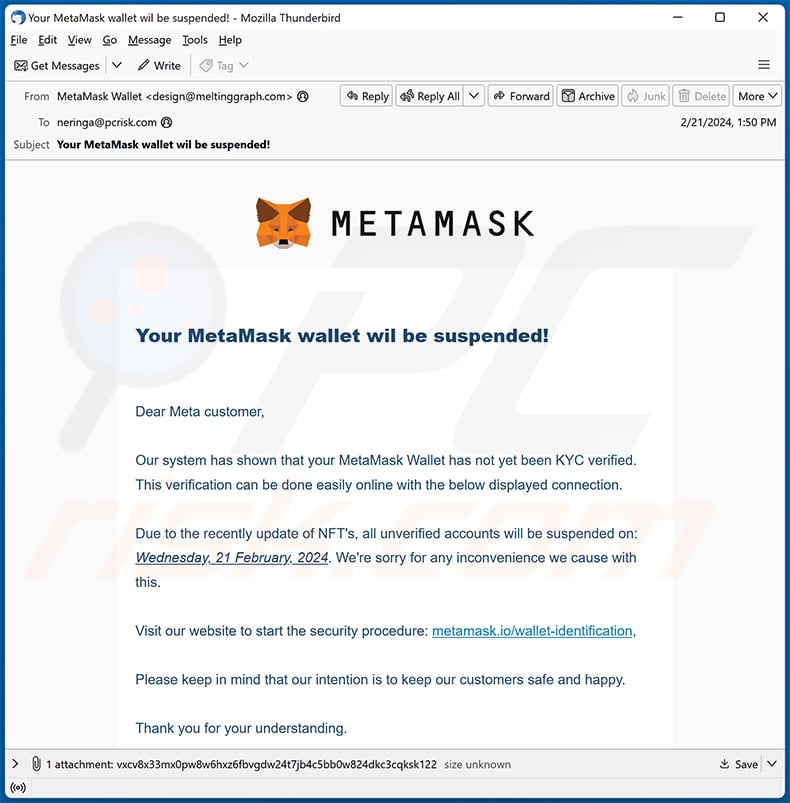
Text presented within:
Subject: Your MetaMask wallet wil be suspended!
MetaMaskYour MetaMask wallet wil be suspended!
Dear Meta customer,
Our system has shown that your MetaMask Wallet has not yet been KYC verified. This verification can be done easily online with the below displayed connection.
Due to the recently update of NFT's, all unverified accounts will be suspended on: Wednesday, 21 February, 2024. We're sorry for any inconvenience we cause with this.
Visit our website to start the security procedure: metamask.io/wallet-identification,
Please keep in mind that our intention is to keep our customers safe and happy.
Thank you for your understanding.
The MetaMask Team
MetaMask - A crypto wallet & gateway to blockchain apps [Photo]ConsenSys, 49 Bogart St, New York, NY 11206, United States
Instant automatic malware removal:
Manual threat removal might be a lengthy and complicated process that requires advanced IT skills. Combo Cleaner is a professional automatic malware removal tool that is recommended to get rid of malware. Download it by clicking the button below:
▼ DOWNLOAD Combo Cleaner
By downloading any software listed on this website you agree to our Privacy Policy and Terms of Use. To use full-featured product, you have to purchase a license for Combo Cleaner. 7 days free trial available. Combo Cleaner is owned and operated by Rcs Lt, the parent company of PCRisk.com read more.
Quick menu:
- What is MetaMask spam?
- Types of malicious emails.
- How to spot a malicious email?
- What to do if you fell for an email scam?
Types of malicious emails:
![]() Phishing Emails
Phishing Emails
Most commonly, cybercriminals use deceptive emails to trick Internet users into giving away their sensitive private information, for example, login information for various online services, email accounts, or online banking information.
Such attacks are called phishing. In a phishing attack, cybercriminals usually send an email message with some popular service logo (for example, Microsoft, DHL, Amazon, Netflix), create urgency (wrong shipping address, expired password, etc.), and place a link which they hope their potential victims will click on.
After clicking the link presented in such email message, victims are redirected to a fake website that looks identical or extremely similar to the original one. Victims are then asked to enter their password, credit card details, or some other information that gets stolen by cybercriminals.
![]() Emails with Malicious Attachments
Emails with Malicious Attachments
Another popular attack vector is email spam with malicious attachments that infect users' computers with malware. Malicious attachments usually carry trojans that are capable of stealing passwords, banking information, and other sensitive information.
In such attacks, cybercriminals' main goal is to trick their potential victims into opening an infected email attachment. To achieve this goal, email messages usually talk about recently received invoices, faxes, or voice messages.
If a potential victim falls for the lure and opens the attachment, their computers get infected, and cybercriminals can collect a lot of sensitive information.
While it's a more complicated method to steal personal information (spam filters and antivirus programs usually detect such attempts), if successful, cybercriminals can get a much wider array of data and can collect information for a long period of time.
![]() Sextortion Emails
Sextortion Emails
This is a type of phishing. In this case, users receive an email claiming that a cybercriminal could access the webcam of the potential victim and has a video recording of one's masturbation.
To get rid of the video, victims are asked to pay a ransom (usually using Bitcoin or another cryptocurrency). Nevertheless, all of these claims are false - users who receive such emails should ignore and delete them.
How to spot a malicious email?
While cyber criminals try to make their lure emails look trustworthy, here are some things that you should look for when trying to spot a phishing email:
- Check the sender's ("from") email address: Hover your mouse over the "from" address and check if it's legitimate. For example, if you received an email from Microsoft, be sure to check if the email address is @microsoft.com and not something suspicious like @m1crosoft.com, @microsfot.com, @account-security-noreply.com, etc.
- Check for generic greetings: If the greeting in the email is "Dear user", "Dear @youremail.com", "Dear valued customer", this should raise suspiciousness. Most commonly, companies call you by your name. Lack of this information could signal a phishing attempt.
- Check the links in the email: Hover your mouse over the link presented in the email, if the link that appears seems suspicious, don't click it. For example, if you received an email from Microsoft and the link in the email shows that it will go to firebasestorage.googleapis.com/v0... you shouldn't trust it. It's best not to click any links in the emails but to visit the company website that sent you the email in the first place.
- Don't blindly trust email attachments: Most commonly, legitimate companies will ask you to log in to their website and to view any documents there; if you received an email with an attachment, it's a good idea to scan it with an antivirus application. Infected email attachments are a common attack vector used by cybercriminals.
To minimise the risk of opening phishing and malicious emails we recommend using Combo Cleaner Antivirus for Windows.
Example of a spam email:

What to do if you fell for an email scam?
- If you clicked on a link in a phishing email and entered your password - be sure to change your password as soon as possible. Usually, cybercriminals collect stolen credentials and then sell them to other groups that use them for malicious purposes. If you change your password in a timely manner, there's a chance that criminals won't have enough time to do any damage.
- If you entered your credit card information - contact your bank as soon as possible and explain the situation. There's a good chance that you will need to cancel your compromised credit card and get a new one.
- If you see any signs of identity theft - you should immediately contact the Federal Trade Commission. This institution will collect information about your situation and create a personal recovery plan.
- If you opened a malicious attachment - your computer is probably infected, you should scan it with a reputable antivirus application. For this purpose, we recommend using Combo Cleaner Antivirus for Windows.
- Help other Internet users - report phishing emails to Anti-Phishing Working Group, FBI’s Internet Crime Complaint Center, National Fraud Information Center and U.S. Department of Justice.
Frequently Asked Questions (FAQ)
Why did I receive this email?
Spam emails are not personal; they are sent by the thousand with the hope that at least some of the recipients will fall for their scams.
I have provided my personal information when tricked by this spam email, what should I do?
If you've disclosed account credentials - immediately change the passwords/passkeys of all potentially compromised accounts and contact their official support. And if you've provided other private information (e.g., ID card details, credit card numbers, etc.) - contact the relevant authorities without delay.
I have read a spam email but didn't open the attachment, is my computer infected?
No, simply opening a spam email is harmless. Infection processes are triggered when the files attached to or the download links contained in these emails - are opened/clicked.
I have downloaded and opened a file attached to a spam email, is my computer infected?
Whether an infection was jumpstarted - depends on the file's format. If it was an executable - then most likely, yes. And if it was a document (e.g., .doc, .pdf, etc.), you might have avoided a malware infection since these formats may require additional actions (e.g., macro command enablement, etc.) - to initiate malicious software download/installation.
Will Combo Cleaner remove malware infections present in email attachments?
Yes, Combo Cleaner can detect and eliminate nearly all known malware infections. It must be stressed that high-end malicious programs tend to hide within systems. Therefore, it is crucial to perform a full system scan.

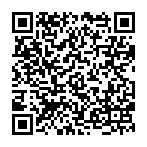
▼ Show Discussion